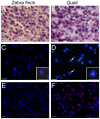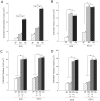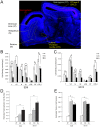Interspecies avian brain chimeras reveal that large brain size differences are influenced by cell-interdependent processes
- PMID: 22860132
- PMCID: PMC3408455
- DOI: 10.1371/journal.pone.0042477
Interspecies avian brain chimeras reveal that large brain size differences are influenced by cell-interdependent processes
Abstract
Like humans, birds that exhibit vocal learning have relatively delayed telencephalon maturation, resulting in a disproportionately smaller brain prenatally but enlarged telencephalon in adulthood relative to vocal non-learning birds. To determine if this size difference results from evolutionary changes in cell-autonomous or cell-interdependent developmental processes, we transplanted telencephala from zebra finch donors (a vocal-learning species) into Japanese quail hosts (a vocal non-learning species) during the early neural tube stage (day 2 of incubation), and harvested the chimeras at later embryonic stages (between 9-12 days of incubation). The donor and host tissues fused well with each other, with known major fiber pathways connecting the zebra finch and quail parts of the brain. However, the overall sizes of chimeric finch telencephala were larger than non-transplanted finch telencephala at the same developmental stages, even though the proportional sizes of telencephalic subregions and fiber tracts were similar to normal finches. There were no significant changes in the size of chimeric quail host midbrains, even though they were innervated by the physically smaller zebra finch brain, including the smaller retinae of the finch eyes. Chimeric zebra finch telencephala had a decreased cell density relative to normal finches. However, cell nucleus size differences between each species were maintained as in normal birds. These results suggest that telencephalic size development is partially cell-interdependent, and that the mechanisms controlling the size of different brain regions may be functionally independent.
Conflict of interest statement
Figures












Similar articles
-
Developmental origins of mosaic brain evolution: Morphometric analysis of the developing zebra finch brain.J Comp Neurol. 2009 May 10;514(2):203-13. doi: 10.1002/cne.22005. J Comp Neurol. 2009. PMID: 19266567
-
Distribution of aromatase-immunoreactive cells in the forebrain of zebra finches (Taeniopygia guttata): implications for the neural action of steroids and nuclear definition in the avian hypothalamus.J Neurobiol. 1996 Oct;31(2):129-48. doi: 10.1002/(SICI)1097-4695(199610)31:2<129::AID-NEU1>3.0.CO;2-D. J Neurobiol. 1996. PMID: 8885196
-
Pronounced early differentiation underlies zebra finch gonadal germ cell development.Dev Biol. 2025 Jan;517:73-90. doi: 10.1016/j.ydbio.2024.08.006. Epub 2024 Aug 28. Dev Biol. 2025. PMID: 39214328
-
Developmental pattern of diacylglycerol lipase-α (DAGLα) immunoreactivity in brain regions important for song learning and control in the zebra finch (Taeniopygia guttata).J Chem Neuroanat. 2013 Nov;53:41-59. doi: 10.1016/j.jchemneu.2013.09.004. Epub 2013 Oct 17. J Chem Neuroanat. 2013. PMID: 24140814 Free PMC article.
-
The zebra finch, Taeniopygia guttata: an avian model for investigating the neurobiological basis of vocal learning.Cold Spring Harb Protoc. 2014 Oct 23;2014(12):1237-42. doi: 10.1101/pdb.emo084574. Cold Spring Harb Protoc. 2014. PMID: 25342070 Free PMC article. Review.
Cited by
-
Heterochromatic regions in Japanese quail chromosomes: comprehensive molecular-cytogenetic characterization and 3D mapping in interphase nucleus.Chromosome Res. 2019 Sep;27(3):253-270. doi: 10.1007/s10577-018-9597-9. Epub 2018 Dec 18. Chromosome Res. 2019. PMID: 30565005
-
Marsupials and Multi-Omics: Establishing New Comparative Models of Neural Crest Patterning and Craniofacial Development.Front Cell Dev Biol. 2022 Jun 23;10:941168. doi: 10.3389/fcell.2022.941168. eCollection 2022. Front Cell Dev Biol. 2022. PMID: 35813210 Free PMC article.
-
Neural crest and the origin of species-specific pattern.Genesis. 2018 Jun;56(6-7):e23219. doi: 10.1002/dvg.23219. Genesis. 2018. PMID: 30134069 Free PMC article. Review.
-
Creating Avian Forebrain Chimeras to assess Facial Development.J Vis Exp. 2021 Feb 18;(168):10.3791/62183. doi: 10.3791/62183. J Vis Exp. 2021. PMID: 33682859 Free PMC article.
-
Embryological staging of the Zebra Finch, Taeniopygia guttata.J Morphol. 2013 Oct;274(10):1090-110. doi: 10.1002/jmor.20165. Epub 2013 Jun 27. J Morphol. 2013. PMID: 23813920 Free PMC article.
References
-
- Iwaniuk AN, Hurd PL (2005) The evolution of cerebrotypes in birds. Brain Behav Evol 65: 215–230. - PubMed
-
- Finlay BL, Clancy B, Darlington RB (2010) Late Still Equals Large. Brain Behav Evol 75: 4–6.
-
- Burish MJ, Kueh HY, Wang SS (2004) Brain architecture and social complexity in modern and ancient birds. Brain Behav Evol 63: 107–124. - PubMed
Publication types
MeSH terms
Grants and funding
LinkOut - more resources
Full Text Sources

